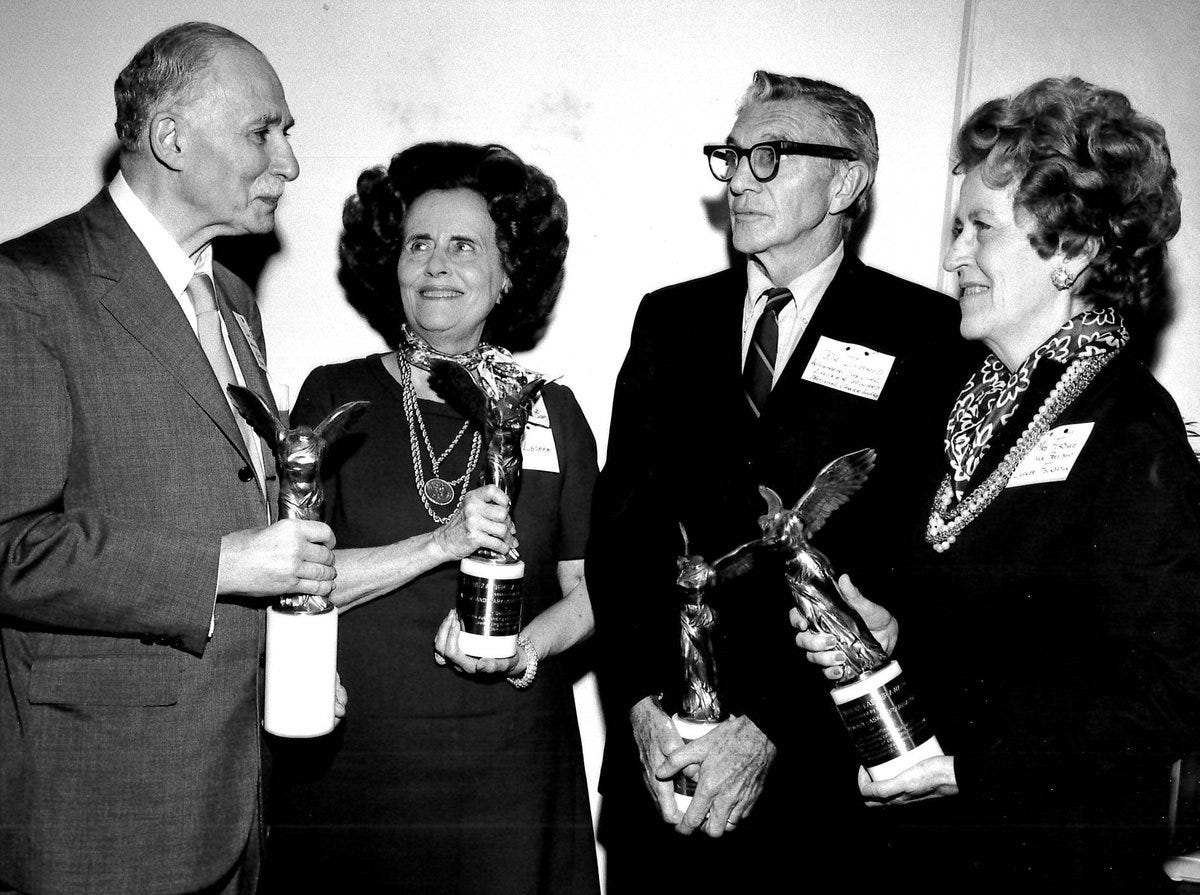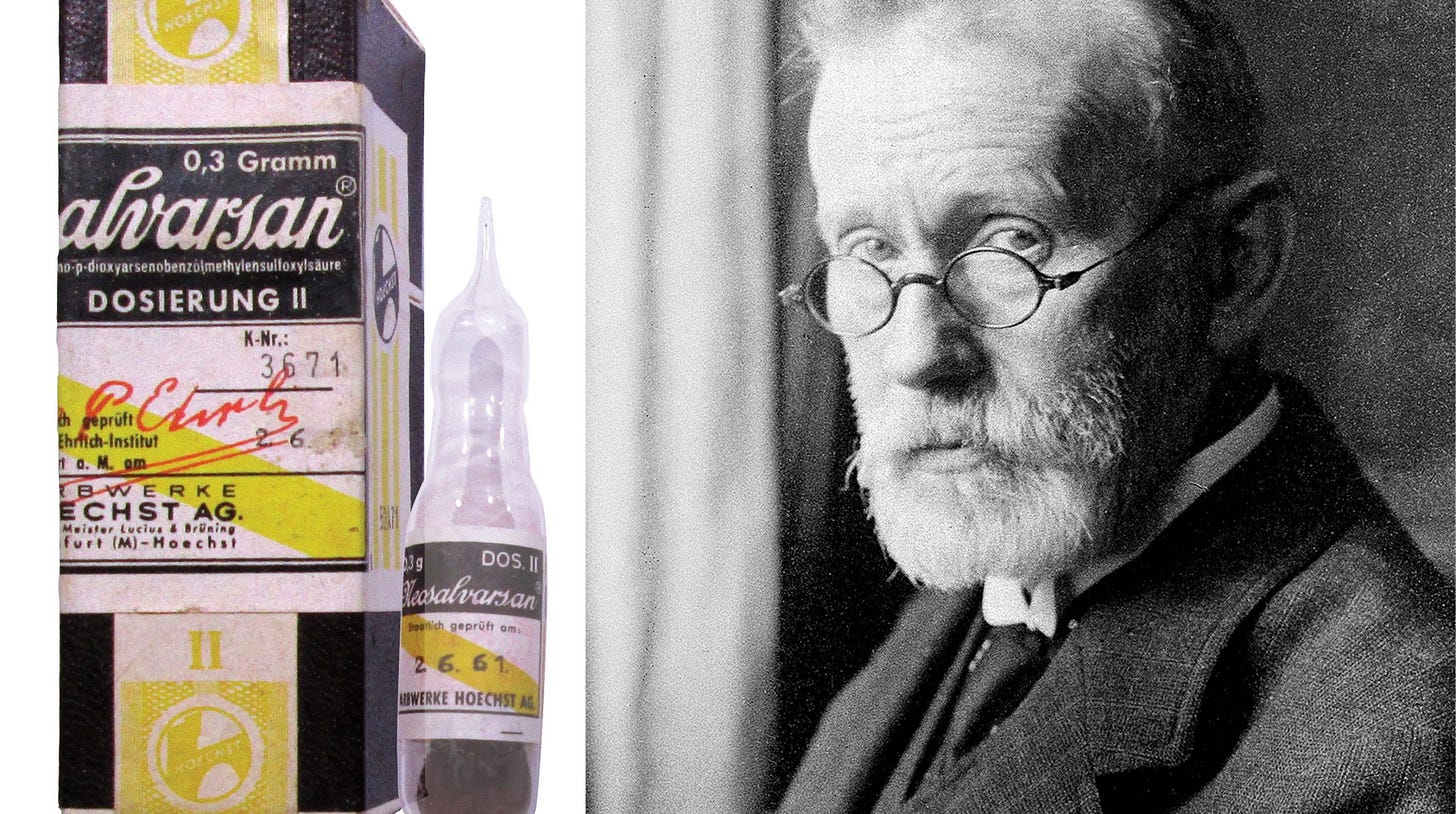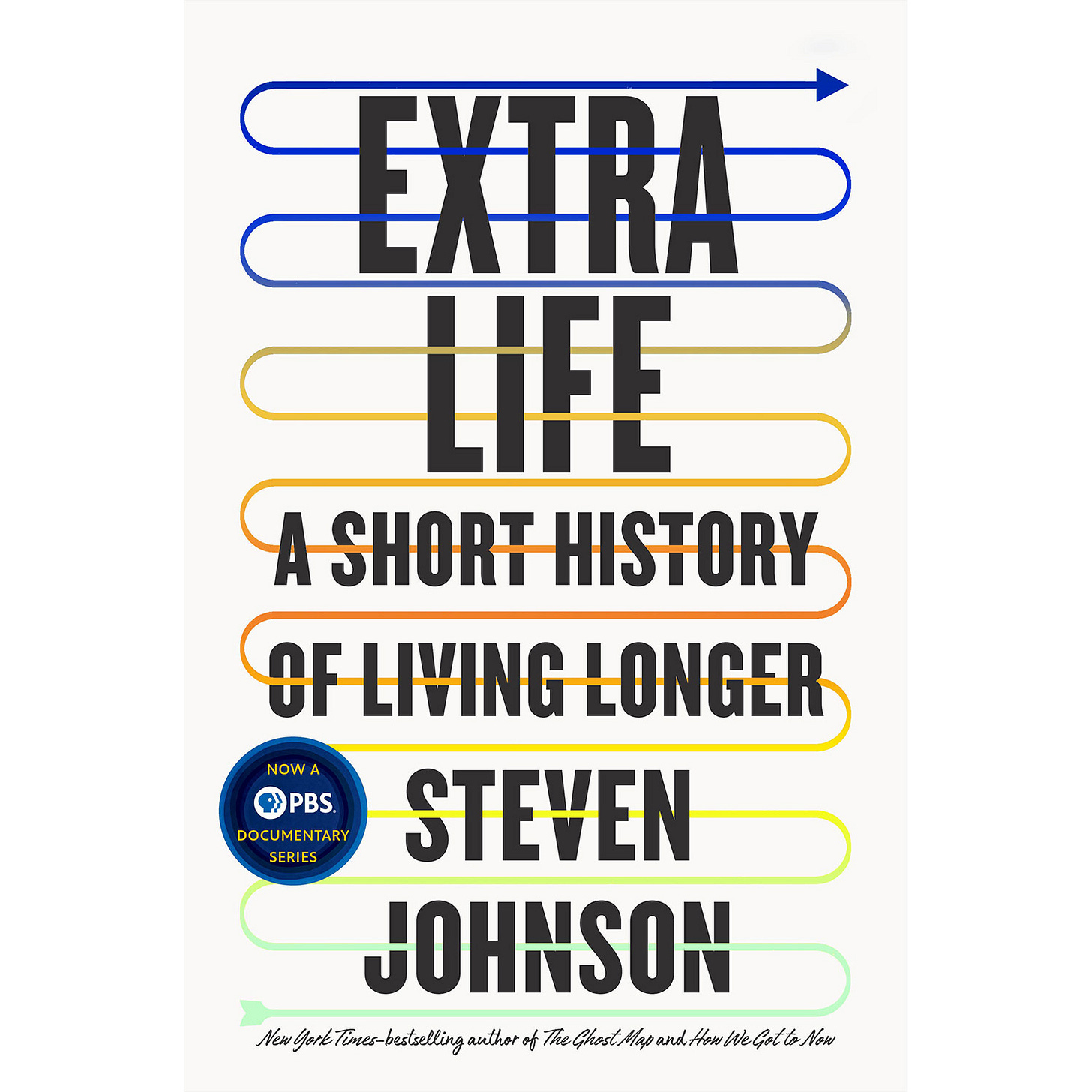In 1909, Paul Erlich, a Jewish physician living in Germany, discovered the first chemotherapy agent.
In the early twentieth century, “chemotherapy” described any compound injected or ingested to treat disease and generally referred to an antibiotic. Dr. Erlich’s discovery, known as “Compound 606” or Salvarsan, was the first successful treatment for syphilis. Derived from arsenic, salvarsan was eventually replaced by penicillin. The discovery of treatments for bacterial infections prompted scientists to search for another “magic bullet” that could cure cancer
Chemical weapon research performed during World War II provided an early sign on where these scientists might start looking. A special unit called the US Army Chemical Corps studied substances that could be used by Allied Forces in chemical warfare. Scientists discovered that nitrogen mustard decimated the bone marrow of rats exposed to the poisonous gas. This discovery soon led to mass production of nitrogen mustard and other compounds which were shipped over to Europe and stored on ships docked outside Allied controlled harbors.
In 1943, Nazi forces bombed one of these storage vessels which was docked outside Bari, Italy. Thousands of nitrogen gas bombs stored on board exploded, exposing hundreds of Allied troops to poison. Examinations of the soldiers’ blood confirmed that what the scientists observed in rats was also true in humans. Nitrogen gas killed the soldiers’ bone marrow.
After the war, pioneering physicians began to investigate how nitrogen mustard could be used to treat patients with cancer. (You can read more about this in the post below.)
How a Jewish cardiologist and Babe Ruth helped cure childhood leukemia
Hello everyone! I understand many of you are in the midst of family get-togethers where topics like science, war, Manchester versus Liverpool, and even baseball may be off the table. If things start getting tense, I invite y…
“By the mid-1940s it was clear that drugs could cause regression of human cancer” an article entitled the Historic Milestones of Curative Chemotherapy explains, “These regressions were partial and transient but were enough to open the door to an era of search for more active agents.” President Eisenhower and Congress recognized the need for a national, coordinated approach. In 1955, the Senate appropriated $5 million for a chemotherapy research program and charged the NCI to find someone to lead the effort.
Dr. C. Gordon Zubrod, a tall, straight-talking Midwesterner, worked on the team that developed penicillin. Zubrod also had experience performing animal studies, even testing whether antibiotics could kill cancer cells. Most importantly, Zubrod was familiar with a new tool in research, the clinical trial.
In 1948, the first randomized clinical trial was published. Patients with tuberculosis were randomly assigned to receive standard treatment (essentially nothing) versus another new antibiotic, streptomycin. The group that received the streptomycin lived longer than the other group.
Steven Johnson, in his book Extra Life: A Short History of Living Longer, describes the consequence of this trial, “The two developments complemented each other: the discovery of antibiotics finally gave the researchers a drug worth testing, and the randomized control trials gave them a quick and reliable way to separate the promising antibiotics from the duds.”
A small group of scientists felt the same approach could be used to tackle a problem most doctors and the American public in the 1950’s thought less possible than landing a spaceship on the moon: curing cancer.
To the scientific community, the thought of using randomized clinical trials was considered as farfetched as curing cancer. Doctors who advocated for either were considered quacks at best.
Standard cancer treatment (which was mostly just surgery) was determined by prevailing expert opinion. If there were two competing opinions, either the two experts debated, or, more often, doctors trained by one expert practiced one way and those trained by the other practiced that way. There were no p-value publications or prospective determinations of how many patients needed to be compared to answer the question.
William Farr, the father of epidemiology: “Facts do not constitute science…it is only when they are compared, when arranged in their natural relations, when crystallized by the intellect, that they constitute the eternal truths of science.”
“Scientists seldom published the results of their experiments. Instead, they described their conclusions and published data that ‘demonstrated’ the truth of these conclusions.”
Sadly, this empiricism is experiencing a resurgence today, particularly on social media. And I understand why patients get confused. Sometimes opinions sound “science-y” so it’s hard to distinguish from true evidence.
Let me give you an example: Let’s say a researcher wants to know why the population of a neighborhood is increasing. Each day he sits on a bench and observes the neighborhood. He notices that each morning a stork flies overhead and each night, he hears the cries of another baby in one of the houses of the neighborhood. The well-meaning scientist concludes that the stork must be delivering babies, thus the increase in population.

Obviously, we know this conclusion is wrong, but the facts are correct. But what if this researcher gained a huge following on YouTube and was endorsed by a celebrity? What if he spoke with great confidence, passion, and clarity suggesting that physicians who discussed family planning were part of a government conspiracy to control people’s lives?
One result might be that people who did not want to have children threw away their birth control methods and instead just avoided living in neighborhoods next to habitats attractive to storks.
Sounds crazy, right? But this is exactly the type of science that influencers and others who peddle “natural” cancer therapies use to capitalize on cancer patient’s fears. In the 1950’s and now.
Zubrod had a plan to change that.
Is There a Natural Cure for Cancer?
The ridiculous class action lawsuit levied against Taco Bell last week brought back memories of my first job: working the drive-thru window at the Taco Bell in Normal, Illinois. As a new employee, I received training on how to prepare the menu items, instructions on taking an order, and a mandate to ALWAYS try to upsell a combo:
When Zubrod took over the fledging research program at the NCI, he faced physicians who scoffed at the utility of statistics and a wary public. Patients trusted their doctors and, unlike today, had few other sources to turn to for information. Some physicians argued that statistics could be manipulated by either side – either to support the conclusion advanced by the surgeon presenting his data or to counter the claims of one who opposed him.
“Statistics are like women, mirrors of purest virtue and truth, or like whores to use as one pleases.” — famous turn-of-the-century German surgeon Dr. Theodore Billroth
In addition, the few doctors who had ready access to chemotherapy were reluctant to share their sources (or credit) with others. As Dr. Zubrod described in his memoir Stairway of Surprise, “What to do about a national program in clinical chemotherapy was a sticky problem for the Center, not only because of the scientists’ opposition but also because Dr. Farber at Harvard, and Dr. Rhoads at Memorial Sloan-Kettering, seemed to have exclusive arrangements with pharmaceutical companies for the clinical trial of promising drugs.”
***Sidenote: When I hear the conspiracy theory that the government has the cure for cancer, I think about that line from Zubrod’s book. I know many, many cancer researchers. All have very healthy egos and are very competitive with others in their field. The person who discovers the cure for cancer will be a shoo-in for the Nobel Prize. There isn’t anything in the world that would stand in the way of a cancer researcher and a Nobel Prize. I am confident that egos and competitiveness will prevent the cure for cancer from being hidden from the rest of us.

Under Zubrod’s leadership, the NCI transitioned from opinions to evidence-based practice. It was Zubrod, for example, that coined the concept of Phase I, II and III clinical trials and set up the cooperative group system, now called the NRG or National Research Group.
When Zubrod died in 1999, scientists remembered him:
“He was quiet. He didn’t get enough credit, but he was a strong person behind the scenes. All of us owe him a great deal.” Dr. Vincent DeVita, former NCI director.
“He came to NCI with a vision that with the proper design of clinical trials and animal models, that progress in the treatment of cancer could occur. That was revolutionary at the time. Most thought the development of science wasn’t good enough. He had a lot of opposition.” Dr. Emil Frei, famous leukemia researcher.
“Zubrod pushed chemotherapy into its important place in medicine, not by doing the experiments, but by facilitating the experiments and seeing what had to be done,” Dr. James Holland, Distinguished Professor of Neoplastic Diseases at Mt. Sinai School of Medicine.
Gordon Zubrod established cancer as a problem that could be solved and created a system to examine solutions. This system led to remarkable cures for diseases like leukemia and lymphoma. It also prioritized drug discovery which led us to the frustrating cul-de-sac we are in now.
We are just beginning to explore the host-tumor relationship and the complexity of an entity that we, for too long, just called “cancer.” We continue to titrate poisons rather than pursuing prevention. We broaden screening recommendations without identifying who actually needs to be screened.
We must accelerate our departure from chemotherapy-based cancer research and lengthy, expensive randomized clinical trials. So many new statistical and biological tools are available that sit shiny and new on the shelf while the antiquated system grinds on.












Amazing to read about the development of chemotherapy (and other drugs) and clinical trials. I appreciated as well your "stork story," which perfectly sums up the proliferation of "opinion-y" science-sounding mis-information on the internet and elsewhere. I remember going through radiation, surgery and chemo and repeatedly coming across the prase "slash, poison, burn..." I wrote a blog post about it at the time. When you are a cancer patient, people you barely know and who have no background in medicine will tell you to "starve your cancer" or use high dose vitamin C (all ideas strongly encouraged by pseudo-scientists on the internet) but to people like me, whose life was saved by chemo, surgery and radiation, this is like rubbing salt in a wound. I am so grateful for the doctors, scientists, and patients who developed and took part in clinical trials, and those who continue to do so. Thank you so much for this amazing piece!
I remember in the run up to chemo the “mustard gas origins” didn’t play as well for me as I think the doctor hoped! But great piece, and interesting to learn about the creation of the clinical trial (and how relatively new it all is!). Thank God for Zubrod.